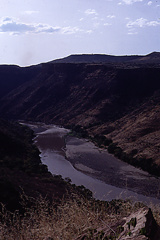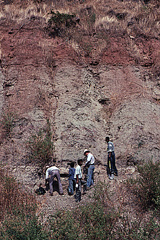

|

Localities of the Jurassic and Cretaceous:Mesozoic Vertebrates from the
|
Twelve fossiliferous sites in the Mugher Mudstone overlying marine limestones of Bathonian to Kimmeridgian age were deposited in estuarine or fluviatile environments and have produced largely fragmentary vertebrate fossils. These include a variety of fossil "fish", represented by abundant ganoid scales, lungfish plates, and numerous shark teeth; two species of turtles; abundant crocodilian cranial elements, osteoderms, and vertebrae; teeth of theropods, cf. Allosaurus; and ornithischian vertebrae, possibly hypsilophodontid. Records of mammals and other small, terrestrial vertebrates remain elusive. Continued field research in this and other parts of Ethiopia will contribute significant data to the emerging picture of the evolution of the Mesozoic faunas of east Africa.


|
Welcome to Blue Nile Gorge, Ethiopia.
At left, the Blue Nile River flows lazily in the bottom of the gorge. At right, the field crew collects fossils along the banks of the Aletu River, near the confluence with the Mugher River at the bottom of the Blue Nile Gorge.
Begin your visit to the Blue Nile Gorge by clicking on "Introduction" below. Once in the exhibit, you may move forwards to the next page, or back to the previous page, by clicking on the yellow arrows at the top of each page. Or, click on the words "Blue Nile Gorge" to the left of the arrows to return to this first page. An outline of the exhibit appears below:


